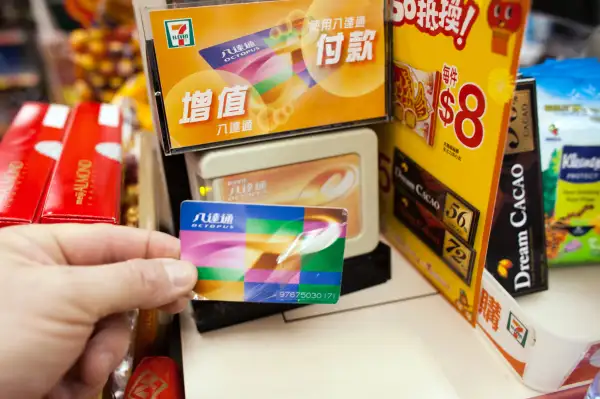Why the U.S. Lags the World in Mobile Payments

When Apple announced its new payment service, Apple Pay, earlier this month, many in the tech world were blown away. The system allows iPhone users to pay at the checkout counter simply by holding their phone to a receiver for a few seconds. Dieter Bohn, writing for The Verge, called Apple Pay "this week's most revolutionary product," and eloquently summarized how most Americans already feel about the status quo: "mobile payments have sucked so far, and it’s high time somebody fixed it."
Bohn is right, but what he likely meant to say was "mobile payments have sucked so far in the United States." Across the globe in Japan, Hong Kong, and Taiwan, viewers of Apple's announcement could be forgiven for falling asleep. Using your phone to buy stuff? We've been doing that for years.
In Hong Kong, residents regularly pay for goods, services, and public transit, all without swiping or signing. Instead, shoppers can simply wave their Octopus card, which uses a technology similar to Apple Pay, at checkout and go on their merry way. Octopus Holdings claims 95% of people in Hong Kong between ages 16 to 65 use its product, and Octopus is accepted at 14,000 retail outlets. Even more impressive, the card's swipeless technology has been incorporated into phones, and yes, watches too. When did this magical future tech launch? Hong Kong has had Octopus since 1997.
Apple Pay-like services are also old news in Japan, a country where mobile payments are already ubiquitous. Afterall, it was Sony that invented the region's major method of short-range data transfer. That technology eventually came to power Hong Kong's Octopus card, as well as a slew of Japanese mobile wallets. Today, nearly every cell phone sold in Japan (other than the iPhone) comes with mobile payment technology built in by default.
Takeshi Natsuno, a former executive at one of Japan's largest wireless carriers, once bragged, "When I leave my house in the morning all I take with me is my phone, which lets me do everything—pay, take public transport—simply by swiping a special reader in shops, stations or airports." Sounds just like the promise of Apple Pay, except Natsuno said that in 2004.
But the world leader in mobile payments isn't a glittering Eastern city. According to the Economist, that title belongs to Kenya and its revolutionary cell phone-based payment system, M-PESA. Launched in 2007, the service allows users to essentially text money back and forth while using telecom giant Safaricom, M-PESA's creator, as a bank. Deposits and withdrawals are made through Safaricom's network of 40,000 agents. Once money is in the system, it can be sent to any other M-PESA customer—even merchants—via a phone menu. Thanks to M-PESA, the Economist notes, "paying for a taxi in Nairobi is easier than it is in New York."
Why is the U.S. so far behind other countries? There isn't a single answer. At least in Asia-Pacific, major players may just be more willing to adopt the latest tech. "The thing hindering mobile payment development and contactless cards is that there's an infrastructure set up in place and banks [and merchants] feel compatible with the current infrastructure," said Theresa Jameson, senior analyst at Datamonitor Financial. "Certain markets are more willing to adopt new payment technologies."
New contactless payments for public transport have also helped put Apple Pay-like technology in the hands of every consumer. Hong Kong's Octopus card, as well as Japan and Taiwan's mobile payment systems, each originated as a better way to pay subway fares. Over time, merchants gradually began to get on board with the new technology until swipeless payment became a norm. Ben Thompson, founder of the website Stratechery, describes how this exact process played out in Taiwan when a new Octopus-style transit card was introduced:
When I first arrived in 2003 almost everything was cash only. Just a year earlier, however, in 2002, the EasyCard Corporation née Smart Card Corporation had rolled out an RFID stored value card for use on Taipei’s new MRT (subway) system... Within a few years you could use the card everywhere: buses, trains, taxis, parking, government fees, and now, 10 years on, almost every retailer, and the RFID chip is no longer limited to cards, but is embedded in some phones, key fobs, and more.
As Thompson points out, another reason behind America's stagnation in the mobile payment space is simply the inertia of the credit card system. Magnetic stripe cards are accepted by as many as 9 million U.S. businesses, and it will take an enormous investment to make Apple Pay even half as prolific. However, in countries like Taiwan and Kenya, where credit card penetration is low, or Japan, where there is a cultural aversion to debt, new alternatives were given an opportunity to flourish because credit cards had not already dominated the market.
But as America slowly prepares to move from magnetic strips to Near Field Communication (NFC) systems like Apple Pay, Asia may be held back by its own form of inertia. "Japan and Hong Kong are faced with a dilemma," says Datamonitor's Jameson. "If they wish to begin using Apple Pay or other NFC-based mobile payment services, they will need to start from the ground up in building their contactless/mobile payments ecosystem like the rest of the world – which would require considerable investment." Their other option? "Stick with their existing system while the rest of the world moves in a different direction."
